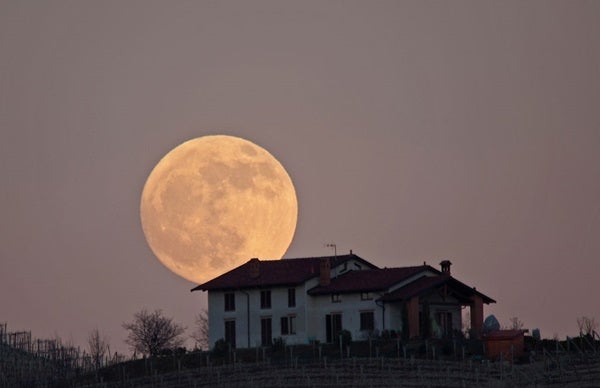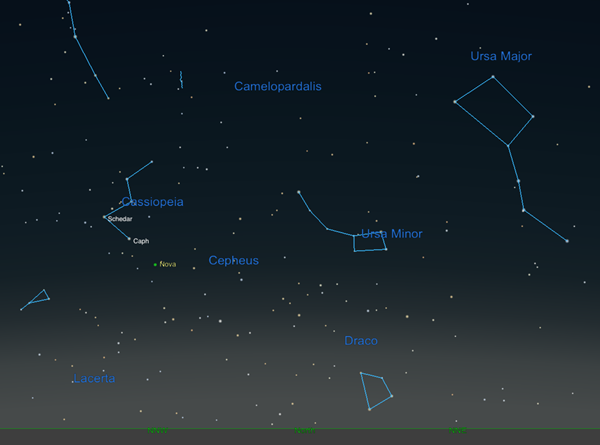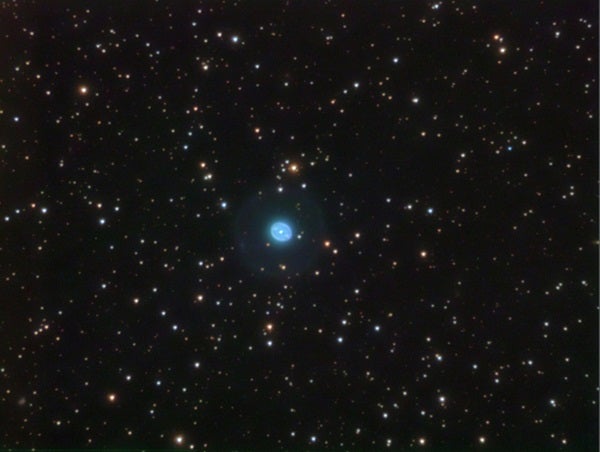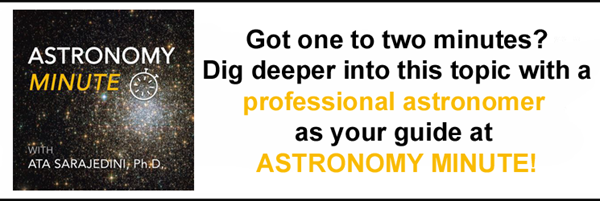Friday, March 26
Venus reaches superior conjunction at 3 A.M. EDT. Although Earth’s sister planet is not currently visible, our next closest sibling, Mars, still shines in the constellation Taurus after dark. It’s currently about 6.2° directly above magnitude 3.5 Ain (Epsilon [ϵ] Tauri), which — depending on how you picture the Bull’s face — serves as his other eye, alongside brighter Aldebaran to its south.
Mars is currently magnitude 1.2 and spans just 5″ across. Although detail is difficult to discern even through a telescope, the Red Planet is still easy to find, even with a relatively bright Moon in nearby Leo. The earlier you can observe Mars after sunset, though, the better — it’s already setting and although it won’t disappear below the horizon until after local midnight, the lower it gets, the more of Earth’s turbulent atmosphere its light must pass through, muddying your view.
Sunrise: 6:53 A.M.
Sunset: 7:19 P.M.
Moonrise: 4:58 P.M.
Moonset: 6:06 A.M.
Moon Phase: Waxing gibbous (94%)
*Times for sunrise, sunset, moonrise, and moonset are given in local time from 40° N 90° W. The Moon’s illumination is given at 12 P.M. local time from the same location.
Saturday, March 27
You may remember the radio dishes featured prominently in the movie Contact. Those dishes belong to the Very Large Array in New Mexico, which has since been upgraded to become the next generation Very Large Array, or ngVLA. And today, from 1–2 P.M. MDT (3–4 P.M. EDT), you can take a guided virtual tour of the ngVLA, as the facility celebrates its 40th anniversary.
The Zoom tour is free and open to all, but registration is required ahead of time. You can find out more or register for the tour at the National Radio Astronomy Observatory’s tour information page.
Whether or not you take the tour, tonight you can celebrate one of this amazing radio telescope’s many accomplishments by observing a star that’s easy to find in the evening sky: Betelgeuse, Orion the Hunter’s right shoulder (which sits on the left side of the constellation, as he’s typically drawn facing Earth).
Betelgeuse, also known as Alpha (α) Orionis, is a magnitude 0.5 red giant star about 650 light-years away. Because it’s so large — it stretches some three times the average Earth-Sun distance — and so close, it’s one of a few stars whose disk astronomers have directly imaged. The VLA has extensively studied Betelgeuse’s atmosphere, helping researchers better understand the atmospheres of aging stars. Last year, the star even underwent a strange, noticeable dimming event, prompting many to wonder whether it might soon explode as a supernova. But now we know that’s not the case, and the star has returned to its normal brightness.
Sunrise: 6:51 A.M.
Sunset: 7:20 P.M.
Moonrise: 6:12 P.M.
Moonset: 6:37 A.M.
Moon Phase: Waxing gibbous (98%)
Sunday, March 28
March’s Full Moon, also known as the Worm Moon, occurs at 2:48 P.M. EDT. Although our bright satellite will dominate the sky, a pair of binoculars will net you something new and exciting: A nova going off in Cassiopeia the Queen.
The new nova, cataloged as PNV J23244760+6111140, V1405 Cas, or Nova Cas 2021, was discovered March 18 by Japanese amateur astronomer Yuji Nakamura. It was already brightening quickly and, by March 19, was spotted at magnitude 7.7 — bright enough to easily find in binoculars. To locate it, follow a line from 2nd magnitude Schedar (Alpha Cassiopeiae) through first magnitude star Caph (Beta [β] Cassiopeiae). That line points right to the nova’s location, about 5.9° northwest of Caph. Or, if you have a telescope with a “go-to” function, you can slew directly to the nova’s coordinates:
Right Ascension: 23h 24m 47.60s
Declination: +61° 11′ 14.0″
As an added bonus, the Bubble Nebula (NGC 7635) is nearby, just 30′ west-northwest of the nova. If you’re an astroimager, it’s a pairing you won’t want to miss.
Astronomers believe this is a classical nova, which occurs when a white dwarf sucks matter off a companion star. Eventually, that material builds up on the surface of the white dwarf, causing a brief, bright thermonuclear reaction that we see on Earth as a nova. Unlike a supernova, this process doesn’t destroy the white dwarf, so classical novae can repeat.
Sunrise: 6:50 A.M.
Sunset: 7:21 P.M.
Moonrise: 7:27 P.M.
Moonset: 7:07 A.M.
Moon Phase: Full
Monday, March 29
If you’re looking to spice up your observing, look no further than the Salt and Pepper Cluster, located in Auriga the Charioteer. Cataloged by Charles Messier as M37, this magnitude 5.6 open cluster is roughly 20′ across and high in the western sky after sunset tonight.
First, locate the bright star Capella; about 12° to its southeast is Bogardus, and M37 is about 5° southwest of this magnitude 2.7 star. The Salt and Pepper Cluster is named for the fact that it simply looks like salt and pepper sprinkled across the dark background of the sky. Its distribution of stars is surprisingly even, unlike many other open clusters, which feature a more random appearance. You can enjoy this cluster in any size telescope, from a small 3-incher up to the largest amateur instruments. More magnification will simply reveal more of the cluster’s many stars.
Sunrise: 6:48 A.M.
Sunset: 7:22 P.M.
Moonrise: 8:42 P.M.
Moonset: 7:36 A.M.
Moon Phase: Waning gibbous (99%)
Tuesday, March 30
The Moon reaches perigee, the closest point to Earth in our satellite’s orbit around us, at 2:16 A.M. EDT. At that time, the Earth-Moon separation will be 223,886 miles (360,310 kilometers).
While the Moon continues to shine bright in the night sky, let’s focus on targets that are easy to see: binary stars.
Start your search with an easy one: Mizar and Alcor in the handle of the Big Dipper. Nearly 12′ apart, many people can distinguish the pair without any optical aid at all. To try your luck, find the end of the Big Dipper’s handle — Alkaid (Eta [η] Ursae Majoris) — and then travel inward to the next star in the handle, right where it kinks. That’s second-magnitude Mizar; magnitude 4 Alcor sits to its east.
But zoom in on Mizar, and you’ll discover that it is also a binary star, this time with both components separated by an easy 14″. (In fact, each of these stars is binary, making Mizar a quadruple-star system. However, these last two stars cannot be resolved with backyard scopes.)
Next, swing your gaze to Leo the Lion, where magnitude 2 Algieba (Gamma [γ] Leonis) splits into two fainter (magnitudes 2.4 and 3.6) stars just 4.2″ apart. These stars have contrasting colors, with one appearing more orange and the other more yellow. You should be able to see them with magnifications of just 75x to 100x. As a bonus, the brighter star hosts a planet nearly 10 times Jupiter’s mass that orbits about as far from its host as Earth orbits the Sun. (Of course, you can’t see it in your telescope, but it’s there!)
Sunrise: 6:47 A.M.
Sunset: 7:23 P.M.
Moonrise: 9:59 P.M.
Moonset: 8:06 A.M.
Moon Phase: Waning gibbous (95%)
Wednesday, March 31
Nestled between the constellations Hydra and Virgo, early risers this morning will find the lesser-known constellation Corvus the Crow. Its four main stars, which create a boxy outline on the sky that doesn’t necessarily resemble a bird, all shine at roughly magnitude 3. Fifth-magnitude Zeta (ζ) Corvi, which lies inside the trapezoid, is a wide double star with components colored blue and yellow. They’re roughly 6′ apart — easy to split.
If you’re more interested in faint objects, seek out M104, also known as the Sombrero Galaxy. It’s located just over the border in Virgo. You’ll find it 5.5° northeast of Algorab (Delta [δ] Corvi) and 11° west of bright Spica (Alpha Virginis). This magnitude 9 spiral is visible in binoculars as well as telescopes, and is named for the dark band of dust encircling its bright center, lending the entire object the appearance of a broad-brimmed hat.
Sunrise: 6:45 A.M.
Sunset: 7:24 P.M.
Moonrise: 11:16 P.M.
Moonset: 8:40 A.M.
Moon Phase: Waning gibbous (88%)
Thursday, April 1
Want to play an April Fool’s joke on your eyes? Wait until late this evening to find NGC 6826, also known as the Blinking Planetary Nebula. This magnitude 8.8 object gets its name from its ability to easily play tricks on the observer’s eye, appearing to “blink” in and out of existence without actually changing at all.
To see this for yourself, first locate the nebula in a medium-sized (6-inch or larger) telescope — you’ll find it about 1.4° east of magnitude 4.5 Theta (θ) Cygni. Once you’ve got the planetary nebula centered, looking directly at it reveals its central magnitude 11 star. Then, use averted vision to glance away from the star — and the hazy, spherical nebula will appear to immediately pop into view! Looking back and forth, at and away from the central star, produces this blinking phenomenon because the cone cells in the center of your retina are more sensitive to bright objects, while the rods capable of picking up fainter objects lie outside the center. Looking away from dim objects, then, makes them appear at the edge of your field of view.
Sunrise: 6:43 A.M.
Sunset: 7:25 P.M.
Moonrise: —
Moonset: 9:19 A.M.
Moon Phase: Waning gibbous (79%)
Friday, April 2
Jupiter and Saturn are becoming more easily visible in the morning sky, day by day. Now nearly 10° and 14° high, respectively, an hour before sunrise, Jupiter shines a bright magnitude –2.1, with Saturn a fainter magnitude 0.6.
Both are located in Capricornus; Saturn rises first, around 4 A.M. local time, with Jupiter following less than an hour later. They’re roughly 12° apart, and both reveal vivid detail through binoculars or, even better, a telescope. This morning, look for Saturn’s largest moon, Titan, shining at magnitude 8.8 about 2.5′ east of the planet. Over at Jupiter, all four Galilean moons are easily visible: From east to west, Callisto and Europa sit on one side of the planet, with Io and Ganymede on the other. In fact, Io has just finished a transit of the planet, slipping off the disk around 5:34 A.M. EDT.
Sunrise: 6:42 A.M.
Sunset: 7:26 P.M.
Moonrise: 12:31 A.M.
Moonset: 10:04 A.M.
Moon Phase: Waning gibbous (69%)














